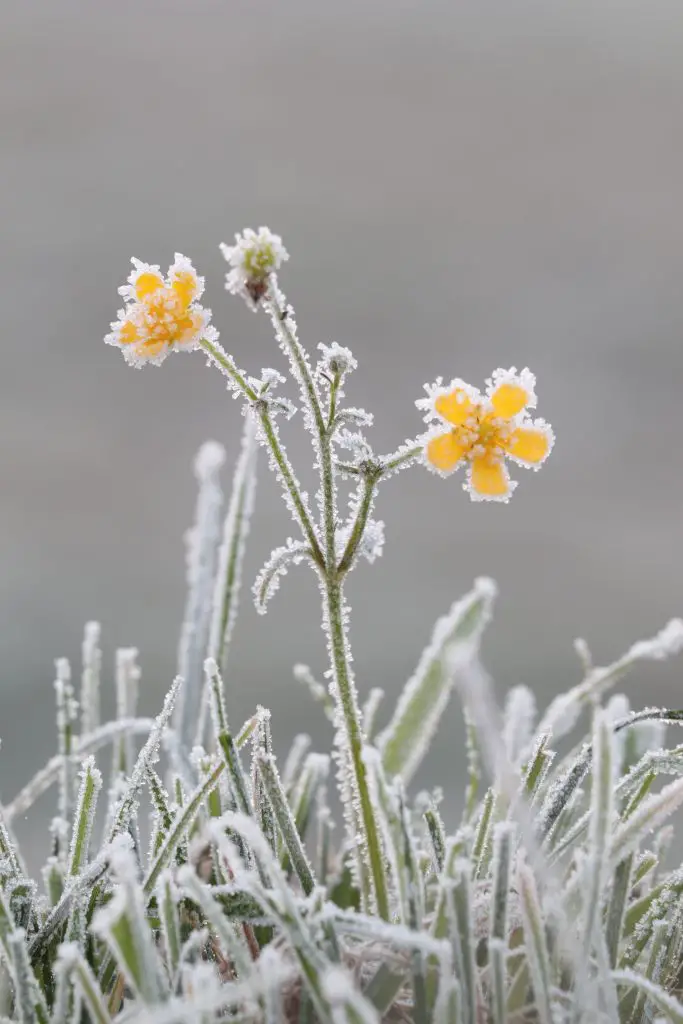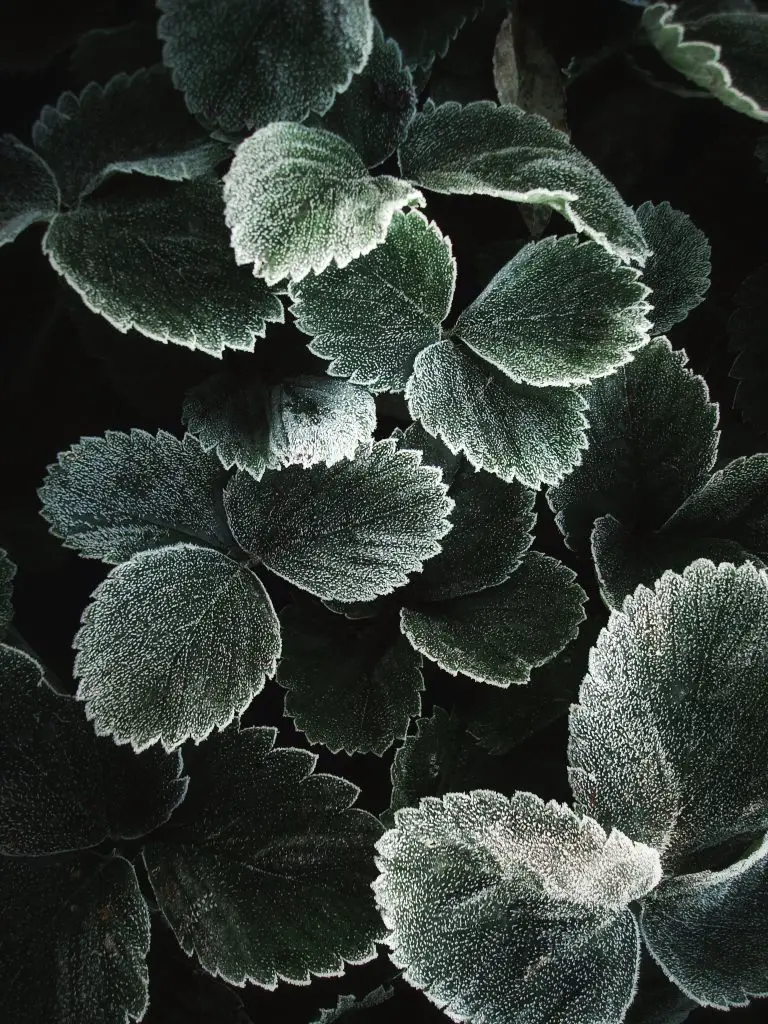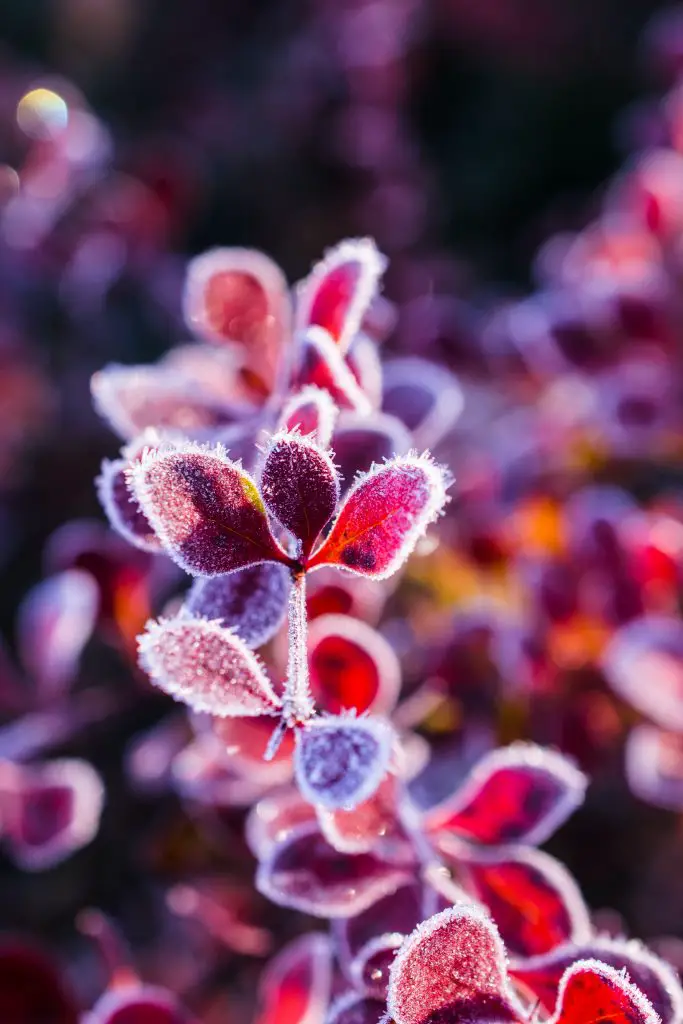At What Temperature Does Frost Occur On Plants? When the local weather channel tells you that you’re in for a cold snap one of the most obvious questions is what does that really mean in terms of frost. Are my plants in danger and what exactly is the temperature at which frost will start to form on the plants and damage them.
The temperature at which theoretically frost will form is around 32°F (0°C), however, if the forecast minimums are below around 40°F (4°C) then you should be assuming that you are going to have frost particularly if you live in the outer suburbs of a major city as they tend to be a few degrees cooler in many cases.
The reason for this is because most weather forecasts for major cities are based on the temperatures within the CBD which are usually elevated by the large volume of concrete surfaces in the general area which will assist in increasing the temperatures by just a few degrees as the heat radiates out at night.
But in general, ice will form on the outside of leaves when the temperature in your area is between 28 to 32°F (-2 to 0°C). In many cases, the moisture is drawn from within the leaves themselves which causes drying and desiccation damage.

However, when the temperature falls below 28°F (-2°F) ice crystals form within the tissues of the plants which in many cases can cause cell walls to rupture structure causing physical damage to the plant’s structure. Typically, what you’ll see is that once the plant has thawed out again the leaves can either appear to have dark green areas that appear to be wet or the plants can turn completely black depending upon the species that you are growing.
Does Watering Make Frost Damage Worse?
One of the most commonly asked questions is is it a good idea to water the plants if you know that the frost is imminent. The answer to that question is that it really does depend upon how low the temperature is going to go.
In cases where the temperature is going to dip into the range of 28 to 32°F (-2 to 0°C) for short periods of time then watering actually generally helps to reduce the extent of frost damage. The reason for this is that water is relatively slow to change temperature compared to other substances. This means that if the temperature is briefly down and the range where frost will occur the water will help to resist the temperature change for a period of time.
However, if the temperatures are going to get below 28°F (-2°C) degrees watering can actually accelerate the rate of damage because the water can contain ice nucleators such as dust and bacteria. These ice nucleators can result in ice formation earlier than would otherwise be the case according to an Australian government website which states that at around 24°F (-4°C) plant tissue can freeze, this normally occurs at under 20°F (-7°C) in the absence of ice nucleators.

How To Reduce Frost Damage
There are several things that you can do that will reduce the extent of frost damage occurring to your plants. The most common practice, which is effective to some degree, is to put frost blankets over the plants. However, if you do not have a specific frost blanket any type of material or cardboard box will provide temporary protection from the frost.
However, the key disadvantage of using something like a cardboard box is that it needs to be removed every morning to allow light to get to the plant whereas frost blankets can be left on for extended periods of time as they will allow light in and protect the plant.
These protections will prevent light frosts from settling on the leaves and reduce the extent of the damage to some degree however if it is really cold then frost will form regardless.
The second commonly used practise to reduce the extent of frost settling on your plants is to plant near something like a brick wall or hard concrete paving. These surfaces absorb energy throughout the day and then radiate that heat back out at night which will increase the temperatures a little bit which is some cases will be enough to protect the plant from damage.
When selecting a location to place a sensitive plant it is important to ensure that the plant is facing Southwood ( in the Northern Hemisphere) as this will ensure that the wall receives the maximum amount of solar exposure.

In cases where you are growing plants inside a greenhouse and the temperatures are falling well below freezing there are also a couple of things that you can do to protect your plants. The first thing is to insulate your glass house with bubble wrap and also use reflective bubble wrap to reflect sunlight around the Greenhouse multiple times.
Additionally, it is a good idea to place black plastic containers full of water in the greenhouse as they will also absorb heat during the day and radiated out at night to ensure that your plants are protected.
The final protection that you can put in place which will absolutely ensure that your plants do not freeze is to purchase a greenhouse heater. To ensure that you are not turning it on or off we would recommend that you purchase one that has a thermostat attach to it as this will give better temperature control over time. To see an example of this type of product click on the link to visit Amazon.
The other thing that we also highly recommend if frost damage does actually occur is to not remove the damaged foliage in the winter. The reason for this is that the foliage itself that has died back will serve to protect the new shoots that are coming to minimize damage.
These damaged limbs and leaves should not be removed until the risk of frost has passed in early spring when the weather is starting to warm up.
I hope you found this article useful and are able to successfully grow your plants in frosty conditions, if you have any additional comments or questions please leave them in the section below.
Relevant Articles
When Should I Plant Winter Vegetables?
At What Temperature Should You Cover Fruit Trees?
Can I Leave My Lemon Tree Outside In Winter?
